Cooling the world's tallest buildings
The last beam has been put in place, and Shanghai Tower is now officially the world’s second-tallest building. But its architects and owners didn’t just set out to go high – they also wanted to go green.
DATE 2024-01-12
So this 632-metre-tall “green vertical city” will get heating and cooling from geo thermal energy sources, while supplementary electricity will come from vertical-axis wind turbines located near the top of the tower. The double-layered insulating glass façade is intended to reduce the need for indoor air conditioning, and is composed of an advanced reinforced glass with a high tolerance for shifts in temperature.
About a quarter less structural steel than a conventional design of a similar height was used in its construction, while more than 30 percent of the site will be green space and landscaping to breathe fresh air into Shanghai and help keep the tower cool.
Alfa Laval was selected to contribute solutions to Shanghai Tower’s sustainability goals, supplying more than 40 cooling units from its energy-efficient T-series and M-series plate heat exchanger lines. Six different models will be used in a range of processes in the building.
Alfa Laval has worked in close cooperation with tower designers and engineers since it was chosen to supply the plate heat exchangers for heating, ventilation and air conditioning.
The 121-storey Shanghai Tower will be completed in 2014, standing as the tallest of a “harmonious skyscraper community” alongside the 420-metre-high Jinmao Tower and the 492-metre-high World Financial Center in the Lujiazui Finance & Trade Zone.

